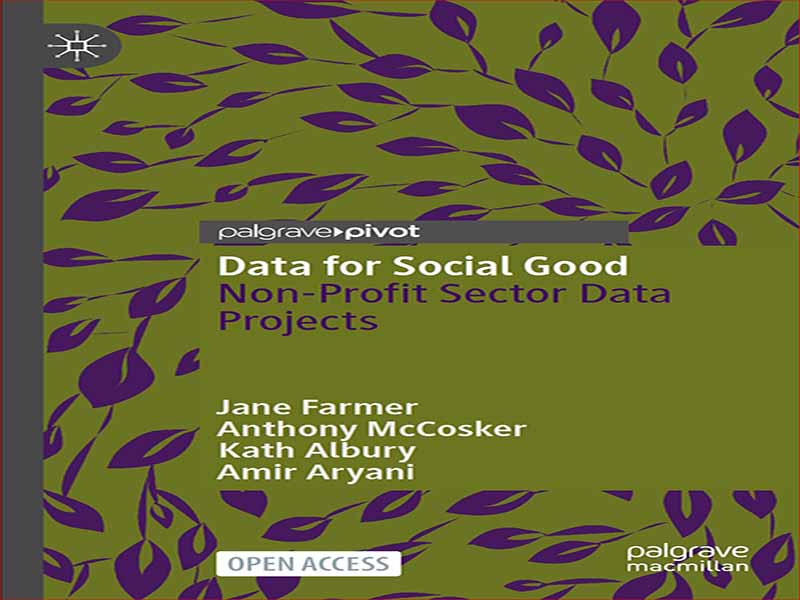- عنوان کتاب: Data for Social Good / Non-Profit Sector Data Projects
- نویسنده: Jane Farmer
- حوزه: موسسه غیرانتفاعی
- سال انتشار: 2022
- تعداد صفحه: 140
- زبان اصلی: انگلیسی
- نوع فایل: pdf
- حجم فایل: 3.30 مگابایت
بخش غیرانتفاعی شامل سازمانهایی با ساختارهای قانونی و عملیاتی متفاوت است، از جمله خیریهها، بنیادهای بشردوستانه، سازمانهای داوطلبانه و اجتماعی، گروههای اجتماعی، شرکتهای اجتماعی و تعاونیها (سالامون و سوکولوفسکی، 2018). برخی از موسسات غیر انتفاعی سود تولید می کنند اما آن را دوباره برای اهداف اجتماعی سرمایه گذاری می کنند. این بخش در سطح بین المللی نام های مختلفی دارد، از جمله بخش خیریه و غیر انتفاعی (کانادا). بخش سوم، اقتصاد اجتماعی، بخش داوطلبانه (بریتانیا)؛ سوم و اقتصاد اجتماعی (اروپا)؛ بخش غیر انتفاعی، بخش اجتماعی (استرالیا و نیوزیلند)؛ و سازمان های خیریه، داوطلبانه و بشردوستانه، جامعه مدنی (ایالات متحده آمریکا) (لالاند، 2018؛ کمیسیون بهره وری، 2010؛ سالامون و سوکولوفسکی، 2018). سازمانهای غیردولتی (NGOs) سازمانهای غیرانتفاعی هستند که تمایل دارند در زمینههای دیگر کشور کار کنند (Vaughan & Arsneault، 2013). در حالی که سازمانهای غیرانتفاعی عموماً برای رسیدگی به اهداف اجتماعی که توسط دولت یا سازمانهای خصوصی به درستی مورد توجه قرار نمیگیرد، فعالیت میکنند (ووگان و آرسنو، 2013)، نقش رفاه اجتماعی سازمانهای غیرانتفاعی میتواند حتی در داخل کشورها متفاوت باشد. برای مثال، فرهنگهای بومی از جمله مائوریهای Aotearoa (نیوزیلند)، درک متفاوتی از زندگی اجتماعی و اجتماعی دارند که بر کارهایی که برای سازمانهای اجتماعی قابل قبول تلقی میشود، تأثیر میگذارد. مفاهیم غربی از داوطلبی، جدایی خانواده و جامعه، و اینکه چه کسی باید خدمات اجتماعی ارائه دهد، نباید به طور خودکار با درک فرهنگی مردم بومی همسو باشد (تنانت و همکاران، 2006). در کشورهای با درآمد بالا، سازمان های غیرانتفاعی ارائه دهندگان قابل توجهی از خدمات اجتماعی از جمله برنامه های بهداشت، سلامت روان، مراقبت های اجتماعی، آموزش، حفاظت از محیط زیست و برنامه های امداد در بلایا هستند. آنها کمک قابل توجهی به اقتصاد ملی می کنند. برای مثال، استخدام حدود 13 درصد از نیروی کار اروپا (سالامون و سوکولوفسکی، 2018). خیریه ها به تنهایی از هر ده کارگر یک نفر را در استرالیا استخدام می کنند (Social Ventures Australia and Center for Social Impact، 2021). فراتر از ارائه خدمات، مؤسسات غیرانتفاعی به ایجاد حس اجتماعی، «بیان انبوهی از علایق و ارزشها – اعم از مذهبی، قومی، اجتماعی، فرهنگی، نژادی، حرفهای یا مرتبط با جنسیت» کمک میکنند (سالامون و سوکولوفسکی، 2018، ص 56) و مهمتر از همه، به عنوان حامیان سیاست اجتماعی عمل می کنند (سالامون، 2014). به این ترتیب، غیر انتفاعی بازیگران کلیدی در جامعه سیاست گذاری هستند. آنها بر آنچه به عنوان چالشهای اجتماعی شناخته میشوند تأثیر میگذارند، شواهدی را در مورد راهحلهای ثمربخش ارائه میکنند و بر نحوه انجام کار بخش خود تأثیر میگذارند (Vaughan & Arsneault، 2013). دولت از طریق قراردادهایی برای ارائه خدمات رفاهی، تامین کننده اصلی سرمایهگذاری برای سازمانهای غیرانتفاعی در کشورهای با درآمد بالا است (سالامون و سوکولوفسکی، 2018). این به طور فزاینده ای منجر به این می شود که دولت ها شرایط تعامل را دیکته کنند. در نتیجه، ضروری است که بخش غیرانتفاعی در شیوهها و نوآوریهای سازمانی معاصر توانمند باشد تا بتواند از طریق دانش و ایدههای مبتنی بر دادهها بر سیاستهای اجتماعی تأثیر بگذارد. در کشورهایی که سیاست آغشته به ایدئولوژی نئولیبرال است، از جمله بریتانیا، استرالیا و نیوزلند، افزایش ارائه خدمات رفاهی عمومی توسط سازمان های غیرانتفاعی در دهه 1980-1990 آغاز شد (تنانت و همکاران، 2006). در طول این مدت، بسیاری از سازمان های داوطلبانه سنتی به مشاغل غیر انتفاعی تبدیل شدند. علاوه بر این، روند ارائه خدمات رفاهی غیرانتفاعی پس از بحران مالی جهانی 2008 تسریع شد. بازاری شدن بخش غیر انتفاعی منجر به رقابت برای تامین مالی بین سازمان ها شد و باعث افزایش شرکت های بزرگ شد. برخی اکنون به یک مجتمع صنعتی غیرانتفاعی مراجعه میکنند (تحریک! زنان رنگارنگ علیه خشونت، 2017)، با این نگرانی که غیرانتفاعیها مجبورند مأموریت اجتماعی خود را برای پاسخگویی به اولویتهای تعیینشده توسط سرمایهگذاران برای بقای خود زیر پا بگذارند.
The non-profit sector comprises organisations with different legal and operational structures, including charities, philanthropic foundations, voluntary and community organisations, community groups, social enterprises and co-operatives (Salamon & Sokolowski, 2018). Some non-profits generate profit but re-invest it for social purpose. The sector has different names internationally, including the charitable and non-profit sector (Canada); third sector, social economy, voluntary sector (UK); third and social economy (Europe); not-for-profit sector, community sector (Australia and New Zealand); and charitable, voluntary and philanthropic organisations, civil society (US) (Lalande, 2018; Productivity Commission, 2010; Salamon & Sokolowski, 2018). Non-governmental organisations (NGOs) are non-profits that tend to work in other country contexts (Vaughan & Arsneault, 2013).
While non-profits generally operate to address social purposes not suitably addressed by government or private organisations (Vaughan & Arsneault, 2013), the social welfare role of non-profits can vary even within countries. Indigenous cultures including the Maori of Aotearoa (New Zealand), for example, have different understandings of social and community life that influence what is considered acceptable work for community organisations. Western notions of volunteering, separation of family and community, and who should provide community services should not be regarded as automatically aligned with Indigenous Peoples’ cultural understandings (Tennant et al., 2006). In high-income countries, non-profits are significant providers of community services, including health, mental health, social care, education, environmental protection and disaster relief programmes. They contribute significantly to national economies; for example, employing around 13% of Europe’s workforce (Salamon & Sokolowski, 2018). Charities alone employ one in ten workers in Australia (Social Ventures Australia and Centre for Social Impact, 2021). Beyond service provision, non-profits contribute to generating a sense of community, “giving expression to a host of interests and values—whether religious, ethnic, social, cultural, racial, professional or gender-related” (Salamon & Sokolowski, 2018, p. 56) and, importantly, act as social policy advocates (Salamon, 2014). As such, non-profits are key actors in the policy community. They influence what are recognised as societal challenges, provide evidence about fruitful solutions and influence how the work of their sector is done (Vaughan & Arsneault, 2013). Government is a major funder for non-profits in high-income countries via contracts to provide welfare services (Salamon & Sokolowski, 2018). This increasingly leads to governments dictating the terms of engagement. Consequently, it is imperative that the non-profit sector is capable in contemporary organisational practices and innovations so it can influence social policy through data-supported knowledge and ideas.
In countries where policy is imbued with neoliberal ideology, including the UK, Australia and New Zealand, increased provision of public welfare services by non-profits started in the 1980s–1990s (Tennant et al., 2006). During this time, many traditional voluntary organisations became non-profit businesses. Additionally, the trend of non-profits supplying welfare services accelerated following the 2008 Global Financial Crisis. The marketisation of the non-profit sector led to competition for funding between organisations, forcing increasing corporatisation. Some now refer to a not-for-profit industrial complex (Incite! Women of Color Against Violence, 2017), with concerns non-profits are forced to subordinate their social mission to respond to funder-determined priorities in order to survive.
این کتاب را میتوانید از لینک زیر بصورت رایگان دانلود کنید:
Download: Data for Social Good




































نظرات کاربران